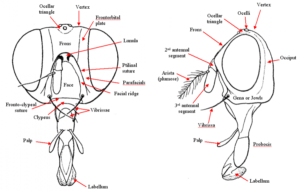In this activity, use jello and vinegar to introduce students to how Houseflies feed.
A human's way of eating is rather boring, compared to the technique used by flies! Without barfing frequently, a housefly would not survive!
Houseflies don’t have mouths that bite, chew or jab. When a fly lands on something, it "tastes", or senses chemistry, with its feet. Then, if the fly finds something tasty, it will barf (regurgitate) on it. Fly vomit contains digestive enzymes, which break down the food so that the fly can stick out its proboscis and use its sponge-like tongue (labellum) to mop up the barf soup.
Other animals also eat "vomit":
- Birds : Doves, finches, penguins, herons and others all regurgitate partially processed food into the mouths of their hungry babies. The food that baby birds receive doesn't actually come from the parent's stomach at all. When the parent bird swallows, their food goes down the throat and into a grinding and storage sack, called the crop. At the nest, the ground food comes out of storage and becomes the babies' meal.
- Canines: Wild Wolves and Coyotes will regurgitate partially digested meat for their young pups to eat when returning to the safety of a den after a hunt.
Next time you complain about what’s put in front of you at dinnertime, just be glad you’re not eating barf!
Human vomit is different, it contains:
- Anything not digested from the last meal
- Acids that kill bacteria
- Digestive Enzymes that break down food
- Mucus that protects the stomach itself from those acids and enzymes
Vomiting is useful to humans because it gets rid of stuff that your body thinks could be dangerous to you. In fact, throwing up is so potentially helpful that there is a part of the brain called the vomit centre that induces vomiting.
Different things can excite the vomit centre to bring on barfing in humans:
- Something bothering the lining of the stomach.
- Confusing information from body position sensors.
- Hormones.
- Unpleasant sights or smells.
Vocabulary:
- Proboscis: an elongated sucking insect mouthpart that is typically tubular and flexible.
- Regurgitate: The expulsion of material from the mouth, pharynx, or esophagus, usually characterized by the presence of undigested food or blood.
- Digestive Enzyme: a substance produced by a living organism in which acts as a catalyst to bring about a specific biochemical reaction (food breakdown).
- Vomit (verb): The forceful expulsion of the contents of one’s stomach through the mouth.
- Vomit (noun): the contents of one’s stomach after it has been expelled out the mouth.
- Pharynx: the part of the throat behind the mouth and nasal cavity.
- Esophagus: part of the alimentary canal that connects the throat to the stomach
- Alimentary Canal: the whole passage along which food passes through the body from mouth to anus


